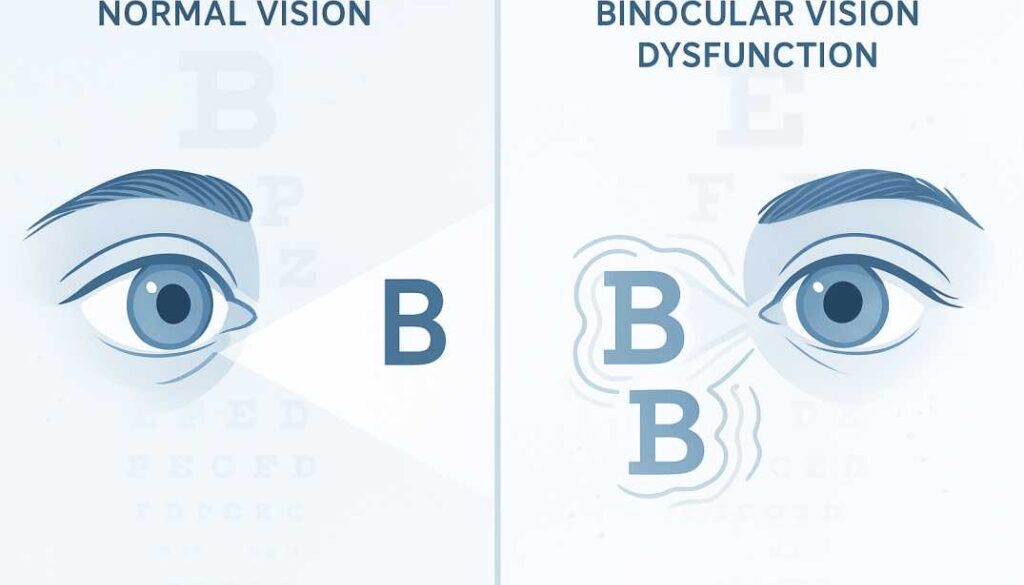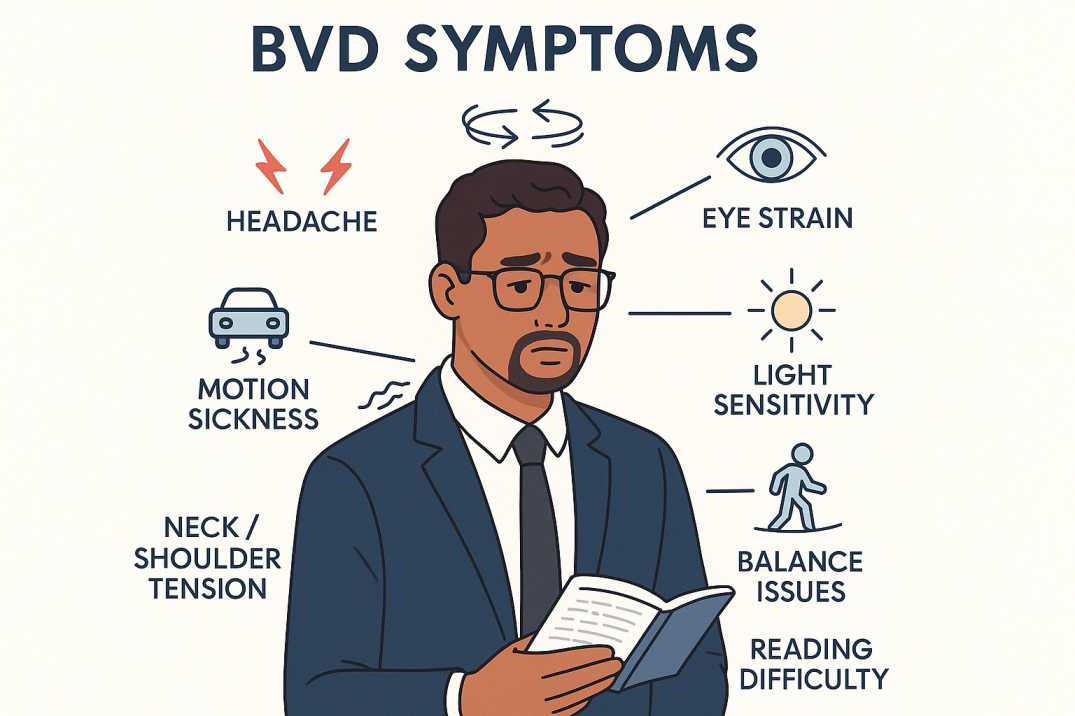Binocular Vision Dysfunction Symptoms: Recognition Guide

Are you experiencing persistent headaches, dizziness, or reading difficulties that doctors can’t explain? You might be dealing with Binocular Vision Dysfunction (BVD), a commonly misdiagnosed condition affecting how your eyes work together.
Understanding Binocular Vision Dysfunction: The Hidden Vision Problem
Binocular Vision Dysfunction occurs when your eyes are slightly misaligned, making it difficult for your brain to merge the images from both eyes into a single, clear picture. Even the smallest misalignment—often undetectable in standard eye exams—can force your eye muscles to work overtime, leading to a cascade of uncomfortable symptoms that significantly impact your daily life.
Unlike common vision problems that affect how clearly you see, BVD affects how well your eyes work together as a team. This coordination problem can develop at any age and affects an estimated 56% of adults and adolescents, making it far more common than most people realize.
How Your Visual System Normally Works
To understand BVD symptoms, it’s important to know how healthy binocular vision functions. When your eyes are properly aligned, they work in perfect synchronization, sending two slightly different images to your brain. Your brain then effortlessly combines these images into one clear, three-dimensional picture—this is what allows you to see depth and navigate the world safely.
When BVD is present, your eyes transmit images that are positioned differently from each other. Your brain struggles to combine these mismatched images and responds by forcing the small eye muscles to constantly realign your eyes. This creates a repetitive cycle of misalignment and forced correction that puts tremendous strain on your visual system.
Core BVD Symptoms: What Your Body Is Telling You
Primary Visual Symptoms
Persistent Headaches and Migraines. One of the most common BVD symptoms is recurring headaches, particularly after visual tasks like reading, computer work, or driving. These headaches often occur at the base of your skull, temples, or forehead and may be misdiagnosed as tension headaches or migraines. The pain typically worsens throughout the day as your eye muscles become increasingly fatigued.
Blurred or Double Vision You may experience blurred vision when looking at objects at any distance, or see double images occasionally. This can happen even if you have 20/20 vision or wear corrective lenses. The blurring often worsens when you’re tired or stressed.
Eye Strain and Fatigue: Your eyes may feel tired, sore, or heavy, especially after reading, using computers, or doing close work. This fatigue can occur within minutes of starting visual tasks and doesn’t improve with rest alone.
Light Sensitivity Many people with BVD experience increased sensitivity to bright lights, fluorescent lighting, or glare from surfaces. This can make environments like grocery stores, malls, or offices particularly uncomfortable.
Physical and Neurological Symptoms
Dizziness and Balance Issues BVD can cause persistent dizziness, lightheadedness, or feelings of unsteadiness. You might feel like the ground is moving beneath you or experience motion sickness in situations where others don’t.
Neck, Shoulder, and Upper Back Pain: Chronic pain in your neck and shoulders often develops as you unconsciously tilt or turn your head to compensate for misaligned vision. This compensation can lead to muscle tension and pain that extends into your upper back.
Motion Sickness and Nausea You may experience nausea or motion sickness while riding in cars, reading in moving vehicles, or even when stationary. Some people feel dizzy when walking through large spaces like stores or airports.
Cognitive and Behavioral Symptoms
Difficulty Concentrating BVD can make it challenging to focus on tasks, leading to decreased productivity at work or school. You might find yourself easily distracted or unable to maintain attention for normal periods.
Reading Problems Common reading difficulties include losing your place, skipping lines, re-reading sections, or feeling that words move or swim on the page. You may read more slowly than others or avoid reading altogether.
Anxiety in Certain Environments Large spaces with high ceilings, busy patterns, or crowded areas can trigger anxiety or panic-like symptoms. This often occurs in places like grocery stores, malls, or airports.
BVD Symptoms in Children vs. Adults
Children with BVD May Show:
- Academic struggles despite normal intelligence
- Avoidance of reading or homework
- Frequent complaints of headaches or tiredness
- Difficulty sitting still or appearing hyperactive
- Problems with sports that require hand-eye coordination
- Tilting their head while reading or watching TV
Adults with BVD Often Experience:
- Increased symptoms during stressful periods
- Difficulty driving, especially at night or in unfamiliar areas
- Problems with computer work or detailed tasks
- Worsening symptoms around age 40 due to natural changes in eye muscle strength
The 5-Minute Self-Test: Quick BVD Assessment
While only a qualified eye care professional can definitively diagnose BVD, there’s a simple test you can try at home to see if your symptoms might be vision-related:
Step 1: Rate your current symptoms (headache, eye strain, dizziness) on a scale of 1-1.0. Step 2: Cover one eye completely with your hand. Step 3: Focus on a distant object and relax for 2-3 minutes. Step 4: Re-rate your symptoms
If your symptoms decrease by 30% or more while one eye is covered, this suggests your discomfort may be related to eye misalignment. This positive result indicates you should seek professional evaluation for BVD.
Why BVD Is Often Misdiagnosed
BVD symptoms are frequently attributed to other conditions because they overlap with many common health issues:
- Migraine disorders – Chronic headaches and light sensitivity
- Anxiety disorders – Panic in crowded spaces and dizziness
- ADHD/Learning disabilities – Difficulty concentrating and reading problems
- Sinus issues – Facial pressure and headaches
- Vertigo or balance disorders – Dizziness and unsteadiness
- Chronic fatigue syndrome – Persistent tiredness and eye strain
Standard eye exams typically focus on visual acuity (how clearly you can see) rather than how well your eyes work together. The specialized testing required to detect binocular vision dysfunction is not included in routine eye examinations, which is why many people with BVD symptoms suffer for years before receiving an accurate diagnosis.
Professional Diagnosis: What to Expect
Comprehensive BVD Evaluation
A thorough BVD assessment goes far beyond a standard eye exam and includes:
Detailed Symptom History: Your eye doctor will review all your symptoms, their frequency, and triggers. This conversation is crucial because BVD symptoms can vary significantly between individuals.
Specialized Alignment Testing: Advanced tests measure how your eyes align at different distances and under various conditions. These tests can detect misalignments as small as 0.25 prism diopters—amounts too small to be detected in routine exams.
Binocular Vision Assessment Testing evaluates how well your eyes work together, including:
- Eye movement coordination
- Convergence ability (eyes turning inward)
- Divergence function (eyes turning outward)
- Focusing flexibility
- Depth perception
- Visual processing speed
Symptom Relief Testing Trial prism lenses may be used during the exam to see if correcting the misalignment immediately reduces your symptoms.
Current Research on BVD: Scientific Support
Recent studies have provided valuable insights into BVD prevalence and treatment effectiveness:
Study 1: Prevalence in University Students (2024)
Research published in the International Journal of Ophthalmology found that among 158 medical students, binocular vision abnormalities were more prevalent than accommodation dysfunction, with convergence insufficiency being the most frequent type. The study revealed that greater binocular refractive disparity leads to more severe eyestrain symptoms.
Study 2: Clinical Population Analysis (2024)
A comprehensive study of 393 subjects aged 6-35 years at a tertiary eye institute found that convergence insufficiency was the predominant binocular issue across all age groups, with accommodative insufficiency and convergence excess following. Notably, 57% of patients were female, suggesting possible gender-related factors in BVD development.
Study 3: Professional Athletes Study (2022)
Research on 107 elite soccer players revealed a 36.4% overall prevalence of binocular vision dysfunction, with esophoria-related dysfunctions being most common (13.0%). This study highlighted that even high-performing athletes can have undiagnosed BVD that may impact their performance.
These studies collectively demonstrate that BVD is significantly more common than previously recognized, with prevalence rates consistently ranging from 20-40% across different populations and demographics, affecting people across all activity levels and age groups.
Treatment Options: Effective Solutions for BVD
Prism Lens Therapy: The Gold Standard
Specialized prism lenses are the most effective treatment for BVD symptoms. These micro-prism lenses work by redirecting light before it enters your eyes, essentially “tricking” your brain into thinking your eyes are properly aligned. This eliminates the constant strain on your eye muscles.
Benefits of Prism Therapy:
- Immediate symptom relief in many cases
- Non-invasive treatment option
- Can be incorporated into regular glasses or contacts
- Addresses the root cause rather than just symptoms
Vision Therapy: Strengthening Your Visual System
Vision therapy involves customized exercises designed to improve eye coordination and strengthen the communication between your eyes and brain. This treatment is particularly beneficial when combined with prism lenses.
Vision Therapy Components:
- Eye movement exercises
- Focusing activities
- Depth perception training
- Hand-eye coordination improvement
- Sustained attention tasks
Lifestyle Modifications
While not cures, certain adjustments can help manage BVD symptoms:
- Take frequent breaks during visual tasks (20-20-20 rule)
- Improve lighting when reading or working
- Use larger fonts and increase contrast on screens
- Practice good posture to reduce neck strain
- Manage stress levels, which can worsen symptoms
BVD in the Digital Age: Screen Time Impact
Modern life’s increased screen time has made BVD symptoms more noticeable and problematic. Extended computer use, smartphone viewing, and digital device interaction can exacerbate existing misalignments and trigger new symptoms. The close focusing required for screens puts additional demand on an already strained visual system.
Digital Eye Strain and BVD:
- Prolonged near focus worsens convergence problems
- Blue light exposure can increase light sensitivity
- Reduced blink rates compound eye strain
- Poor posture while using devices adds neck and shoulder tension
When to Seek Professional Help
You should consider a BVD evaluation if you experience:
- Persistent headaches that worsen with visual tasks
- Unexplained dizziness or balance issues
- Reading difficulties or avoidance
- Chronic eye strain despite corrective lenses
- Neck and shoulder pain with no apparent cause
- Anxiety in visually complex environments
- Any combination of the above symptoms
Red Flags Requiring Immediate Attention:
- Sudden onset of double vision
- Severe headaches with visual changes
- Vision loss or significant vision reduction
- Symptoms following a head injury
Living with BVD: Success Stories and Hope
Many people experience life-changing improvements once their BVD is properly diagnosed and treated. Patients often report:
- Elimination of chronic headaches within days of wearing prism lenses
- Improved reading comfort and speed
- Better balance and reduced dizziness
- Enhanced work productivity
- Decreased anxiety in challenging visual environments
- Overall improved quality of life
Prevention and Eye Health
While some causes of BVD are genetic or developmental, you can take steps to protect your visual health:
- Schedule regular comprehensive eye exams
- Protect your eyes from injury with appropriate safety gear
- Practice good visual hygiene with proper lighting and breaks
- Maintain overall health through nutrition and exercise
- Address any visual symptoms promptly rather than waiting
Finding the Right Eye Care Professional
Not all eye care providers are trained in diagnosing and treating BVD. Look for:
- Optometrists or ophthalmologists with specialized training in binocular vision
- Practices that offer comprehensive binocular vision assessments
- Providers who understand the connection between vision and symptoms like headaches and dizziness
- Clinics equipped with advanced testing technology for detecting small misalignments
References and Additional Resources
The information presented in this clinical review is supported by peer-reviewed research and authoritative medical literature. Healthcare providers and patients seeking additional information may consult these primary sources:
Primary Research Citations
-
Cai, J., Fan, W.W., Zhong, Y.H., Wen, C.L., Wei, X.D., Wei, W.C., Xiang, W.Y., & Chen, J.M. (2024)
“Frequency and associated factors of accommodation and non-strabismic binocular vision dysfunction among medical university students”
International Journal of Ophthalmology, 17(2), 374-379. doi:10.18240/ijo.2024.02.22
https://pmc.ncbi.nlm.nih.gov/articles/PMC10827621/ -
Shrestha, P., & Kaiti, R. (2022)
“Non-strabismic Binocular Vision Dysfunction among the Medical Students of a Teaching Hospital: A Descriptive Cross-sectional Study”
Journal of Nepal Medical Association, 60(252), 693-696. doi:10.31729/jnma.7615
https://www.ncbi.nlm.nih.gov/pmc/articles/PMC9446491/ -
Jorge, J., Diaz-Rey, A., & Lira, M. (2022)
“Prevalence of binocular vision dysfunctions in professional football players”
Clinical and Experimental Optometry, 105(8), 853-859. doi:10.1080/08164622.2021.2002667
https://pubmed.ncbi.nlm.nih.gov/34886745/
Additional Clinical Resources
These peer-reviewed publications provide comprehensive coverage of current research methodologies, diagnostic protocols, and evidence-based treatment approaches for binocular vision dysfunction. Healthcare professionals are encouraged to review these resources for detailed clinical guidelines and therapeutic recommendations.
Conclusion: Take the Next Step Toward Clear, Comfortable Vision
Binocular Vision Dysfunction is a real, treatable condition that affects millions of people. If you recognize yourself in the symptoms described in this guide, you don’t have to continue suffering. The combination of modern diagnostic techniques and effective treatments like prism lenses and vision therapy can provide significant relief and dramatically improve your quality of life.
Remember that BVD symptoms often worsen over time if left untreated, but with proper diagnosis and treatment, most people experience substantial improvement. The first step is recognizing that your symptoms may be vision-related rather than accepting them as “just headaches” or “normal stress.”
Ready to find out if BVD is causing your symptoms? Consider taking the simple 5-minute cover test described above, and if you notice improvement, schedule a comprehensive binocular vision evaluation with a qualified eye care professional. Your eyes—and your overall well-being—are worth the investment in proper diagnosis and treatment.
Disclaimer: This article provides educational information for healthcare professionals and patients. It should not replace professional medical consultation, diagnosis, or treatment. Patients experiencing symptoms consistent with binocular vision dysfunction should seek evaluation by qualified eye care professionals experienced in the diagnosis and management of this condition.
About the Authors: This clinical review incorporates insights from Cook Vision Therapy Center, where Dr. David Cook has provided specialized vision therapy services for over four decades. The practice serves Metro Atlanta from its Marietta location, offering comprehensive binocular vision dysfunction evaluation and treatment to patients throughout the Southeast region.
FAQs
-
Common BVD symptoms include chronic headaches, dizziness, eye strain, difficulty reading, neck pain, and anxiety in large spaces. Take a self-test by covering one eye while reading—if this helps, consult an eye doctor.




